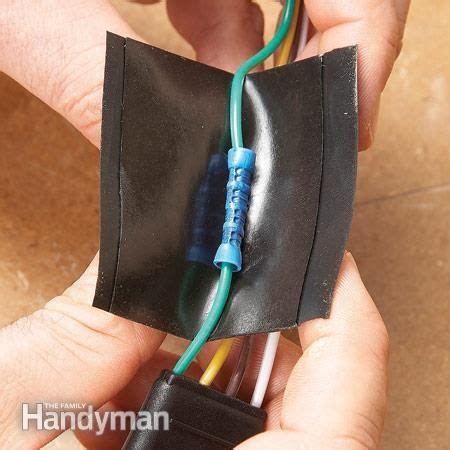How To Splice Trailer Wires
Ronan Farrow
Apr 02, 2025 · 3 min read

Table of Contents
How to Splice Trailer Wires: A Comprehensive Guide
Connecting your trailer to your vehicle's electrical system can seem daunting, but splicing trailer wires is a manageable task with the right knowledge and tools. This guide provides a step-by-step walkthrough to ensure a safe and reliable connection. We'll cover various splicing methods, safety precautions, and troubleshooting tips, helping you confidently tackle this project.
Essential Tools and Materials
Before you begin, gather the necessary tools and materials. Having everything ready will streamline the process and prevent frustrating delays.
- Wire strippers/cutters: Essential for cleanly removing the insulation without damaging the wire.
- Crimping tool: For creating secure and reliable connections with crimp connectors. A good quality crimper is crucial for a long-lasting splice.
- Electrical tape: Provides weatherproof insulation to protect the splice from the elements. Use high-quality, waterproof electrical tape.
- Heat shrink tubing (optional but recommended): Offers superior weatherproofing and strain relief compared to electrical tape alone. Provides a more professional and durable connection.
- Crimp connectors: Choose connectors appropriately sized for your wire gauge. These come in various types, including butt connectors, ring terminals, and spade terminals. Butt connectors are commonly used for splicing wires together.
- Wire connectors (optional): These can be used in conjunction with crimp connectors for added security and insulation, especially in exposed areas.
- Multimeter (optional): Useful for testing continuity and verifying connections after splicing.
Choosing the Right Splicing Method
Several methods exist for splicing trailer wires. The best choice depends on factors such as the wire gauge, the environment, and personal preference.
1. Crimp Connectors (Butt Connectors):
This is the most common and generally recommended method for splicing trailer wires.
- Step 1: Strip the Wires: Carefully strip about ½ inch of insulation from the ends of both wires.
- Step 2: Insert into Connector: Insert the stripped ends of both wires into the crimp connector. Ensure they are fully seated.
- Step 3: Crimp Securely: Use the crimping tool to firmly crimp the connector, ensuring a strong, secure connection.
- Step 4: Insulate: Apply electrical tape or heat shrink tubing to completely cover the connection, ensuring weatherproofing and protection.
2. Wire Nuts (Less Recommended):
While wire nuts are acceptable for house wiring, they are generally less suitable for trailer wiring due to the exposure to the elements and vibrations. If using wire nuts, ensure they are rated for outdoor use and liberally cover the connection with waterproof sealant and electrical tape.
Safety Precautions:
Working with electrical systems requires careful attention to safety.
- Disconnect the Battery: Before working on any wiring, disconnect the negative terminal of your vehicle's battery to prevent accidental shocks or short circuits.
- Properly Insulate: Always thoroughly insulate all splices to prevent short circuits and ensure safety.
- Use the Correct Tools: Using the wrong tools can damage wires and lead to poor connections.
- Inspect Regularly: Regularly inspect your trailer wiring for any signs of damage or wear.
Troubleshooting Common Issues
- No Lights: Check all connections, ensuring that wires are securely crimped and properly insulated. Verify that your trailer lights are working correctly. Use a multimeter to check for continuity.
- Intermittent Lights: This may indicate loose connections or damaged wiring. Re-check all splices and look for any signs of wear or damage.
- Blown Fuse: A blown fuse could indicate a short circuit in your wiring. Check the fuse box and replace any blown fuses.
Conclusion
Splicing trailer wires correctly ensures the safe and reliable operation of your trailer lights and other electrical components. By following these steps and taking necessary precautions, you can confidently complete this task. Remember, if you're unsure about any part of this process, it's always best to consult with a qualified automotive electrician. A well-maintained trailer wiring system contributes significantly to safe towing practices.
Featured Posts
Also read the following articles
| Article Title | Date |
|---|---|
| How To Store Silicone Molds | Apr 02, 2025 |
| How To Sell Spirits | Apr 02, 2025 |
| How To Register A Boat In Idaho | Apr 02, 2025 |
| How To Stop A Fox From Killing Chickens | Apr 02, 2025 |
| How To Tune A Quadrajet | Apr 02, 2025 |
Latest Posts
-
David Vizard How To Build Horsepower
Apr 03, 2025
-
Dave Tompkins How To Wreck A Nice Beach
Apr 03, 2025
-
Dasher How A Brave Little Doe Changed Christmas Forever
Apr 03, 2025
-
Dad Jokes Are How Eye Roll Shirt
Apr 03, 2025
-
Creighton Model How To Chart
Apr 03, 2025
Thank you for visiting our website which covers about How To Splice Trailer Wires . We hope the information provided has been useful to you. Feel free to contact us if you have any questions or need further assistance. See you next time and don't miss to bookmark.
